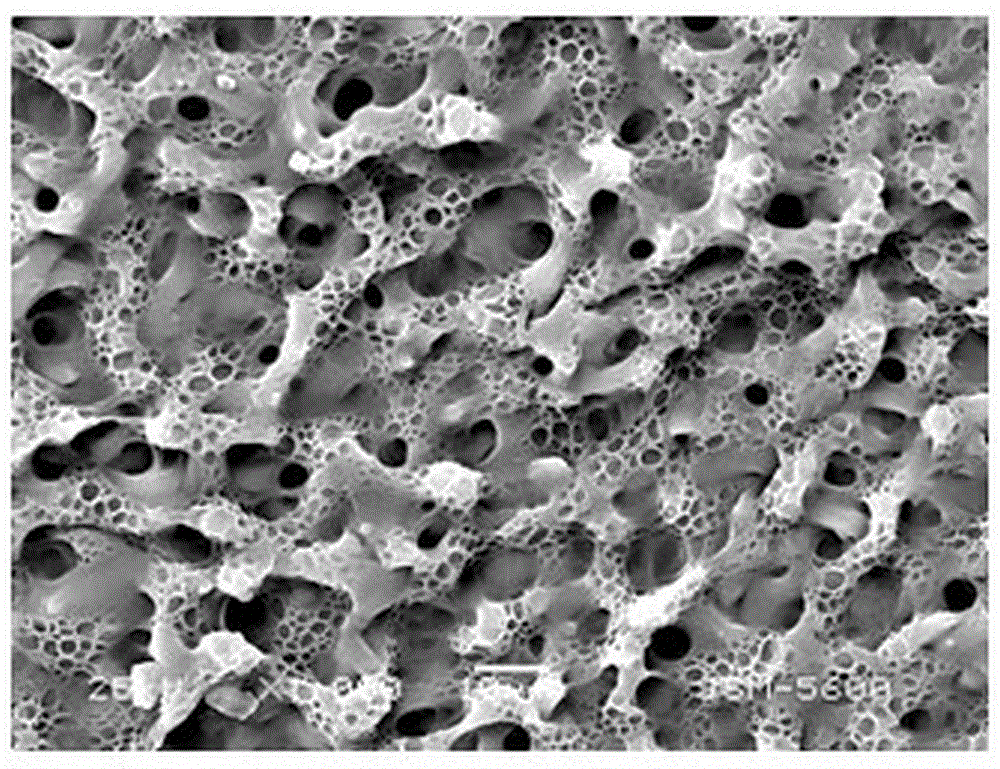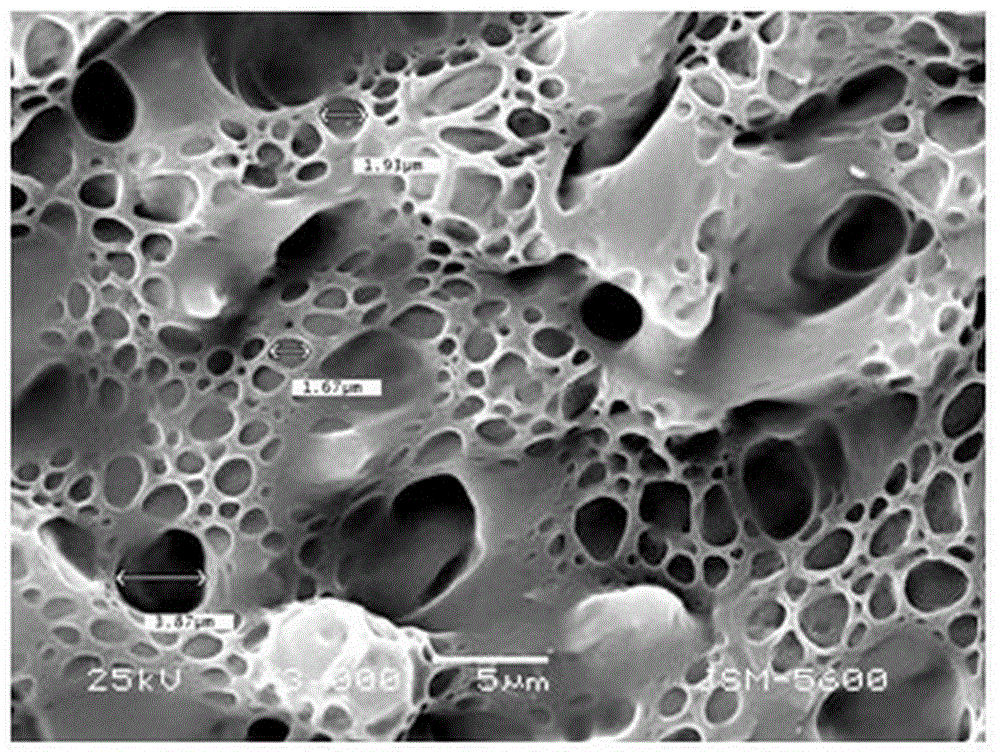Preparation method of latticed microporous film formed by macromolecule crosslinking
A grid-like, high-molecular technology, applied in the field of grid-like high-strength microporous membrane preparation, can solve the problems of slow controlled release of membrane materials, non-discovery, etc., to achieve concentrated distribution of micropores, uniform distribution, drug slow The effect of controlled release
- Summary
- Abstract
- Description
- Claims
- Application Information
AI Technical Summary
Problems solved by technology
Method used
Image
Examples
Embodiment 1
[0015] Example 1 A method for preparing a mesh-like microporous membrane formed by polymer crosslinking, the steps and conditions are as follows:
[0016] (1) The ratio of solvent (mL), film forming agent (g), toughening agent (g) and crosslinking agent (mL) is 100:1:12.5:3, and the mass and volume of the corresponding material are: solvent 20 mL of dimethyl sulfoxide, 0.20 g of polyvinyl alcohol, 2.5 g of thermoplastic polyurethane elastomer as the toughening agent, and 0.6 mL of formaldehyde solution with a mass concentration of 40% as the crosslinking agent;
[0017] (2) According to the proportion, first add the film-forming agent polyvinyl alcohol into a 100mL three-necked flask, add the solvent dimethyl sulfoxide, reflux at 40°C until completely dissolved, add thermoplastic polyurethane elastomer, reflux at 65°C until completely dissolved, and add formaldehyde The solution was refluxed for 30 minutes to obtain a uniform casting solution;
[0018] (3) Cool down the unifo...
Embodiment 2
[0029] Example 2 A preparation method of a grid-shaped high-strength microporous membrane formed by polymer crosslinking, the steps and conditions are as follows:
[0030] (1) The ratio of solvent (mL), film forming agent (g), toughening agent (g) and crosslinking agent (mL) is 100:0.75:10:2.5, and the mass and volume of the corresponding material are: solvent 20 mL of dimethyl sulfoxide, 0.15 g of polyvinyl alcohol, 2.0 g of thermoplastic polyurethane elastomer as the toughening agent, and 0.5 mL of formaldehyde solution with a mass concentration of 40% as the crosslinking agent;
[0031] (2) According to the proportion, first add the film-forming agent polyvinyl alcohol into a 100mL three-necked flask, add the solvent dimethyl sulfoxide, reflux at 40°C until completely dissolved, add thermoplastic polyurethane elastomer, reflux at 65°C until completely dissolved, and add formaldehyde The solution was refluxed for 30 minutes to obtain a uniform casting solution;
[0032] (3)...
Embodiment 3
[0034] Example 3 A method for preparing a mesh-like microporous membrane formed by polymer crosslinking, the steps and conditions are as follows:
[0035] (1) The ratio of solvent (mL), film forming agent (g), toughening agent (g) and crosslinking agent (mL) is 100:1.25:14:3.5, and the mass and volume of the corresponding material are: solvent 20 mL of dimethyl sulfoxide, 0.25 g of polyvinyl alcohol, 2.8 g of thermoplastic polyurethane elastomer as the toughening agent, and 0.7 mL of formaldehyde solution with a mass concentration of 40% as the crosslinking agent;
[0036](2) According to the proportion, first add the film-forming agent polyvinyl alcohol into a 100mL three-necked flask, add the solvent dimethyl sulfoxide, reflux at 40°C until completely dissolved, add thermoplastic polyurethane elastomer, reflux at 65°C until completely dissolved, and add formaldehyde The solution was refluxed for 30 minutes to obtain a uniform casting solution;
[0037] (3) Cool down the uni...
PUM
| Property | Measurement | Unit |
|---|---|---|
| thickness | aaaaa | aaaaa |
| thickness | aaaaa | aaaaa |
| diameter | aaaaa | aaaaa |
Abstract
Description
Claims
Application Information
 Login to View More
Login to View More - R&D
- Intellectual Property
- Life Sciences
- Materials
- Tech Scout
- Unparalleled Data Quality
- Higher Quality Content
- 60% Fewer Hallucinations
Browse by: Latest US Patents, China's latest patents, Technical Efficacy Thesaurus, Application Domain, Technology Topic, Popular Technical Reports.
© 2025 PatSnap. All rights reserved.Legal|Privacy policy|Modern Slavery Act Transparency Statement|Sitemap|About US| Contact US: help@patsnap.com


